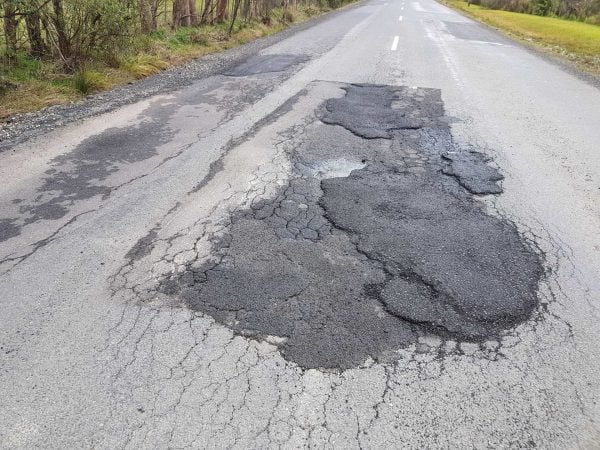Potholes are holes in the road surface that are bigger than 7cm in diameter but not more than a metre square in area or more than 5 cm deep. They’re part of a group of definitions for damage to the road that includes:
- alligator (or crocodile) cracking
- longitudinal cracking
- block cracking
- settlement depressions
- edge cracks
- scabbing
- bleeding
- stripping

Potholes cause hundreds of thousands of dollars of damage to vehicle wheels every year. 276 people made requests for compensation to Auckland Transport in 2017. In the USA, potholes cause over US$3 billion of damage per year.
Potholes can form very quickly in wet weather or where there are repeated frosts and thaws. In fact, they can form in just a few hours and, once a pothole is formed, it can grow rapidly if the road has heavy traffic due to the weight of the traffic crushing the edges of the pothole, further weakening its structure.
Common damage and dangers that potholes can cause
- Flat tyres – the impact to the tyre can burst the tyre’s sidewall as this is the weakest part
- Suspension damage – the impact to the tyre causes the suspension to ‘bottom out’ or reach its maximum travel, bending components
- Wheel damage – the impact to the tyre dents, bends or cracks the wheel
- Steering alignment – the impact can shift the alignment of the wheels which will then cause steering geometry problems and increased tyre wear
- Swerving – drivers swerve to miss the pothole, putting themselves or other road users in danger
- Cyclists and motorcyclists – potholes can cause them to wobble or have to deviate from their path
How can you reduce the damage from potholes?
- Keep your tyres properly inflated – tyres that are under-inflated won’t absorb the impact as well and make it more likely that you will dent or bend the wheel rim, while tyres that are over-inflated will put more pressure on the tyre sidewall
- Look as far ahead as possible so that you can slow down if it’s impossible to avoid the pothole – lower speeds mean less force even if you have to drive over the pothole
- Don’t tailgate other drivers – tailgating reduces the time you will have to react to a pothole
- Keep your steering wheel straight – turning while going through a pothole puts more stress on one side of the tyre
- Release the brakes just before you get to the pothole – braking causes a weight transfer to the front of the car which compresses the front suspension meaning that there’s less suspension travel available when the wheel hits the pothole
What should you do if you’ve hit a pothole?
- If you hit it hard, get out and check your wheel. A small dent or bend in your wheel will increase the chances of the tyre not remaining on the rim, especially when it’s under stress going around a corner. It could have also over-stressed the tyre’s sidewall leaving nit more susceptible to being punctured.
- If you feel a vibration through the steering wheel you may have damaged the wheel rim.
- If the vehicle now pulls to one side, the impact has adjusted the wheel alignment; this needs to be fixed otherwise you will wear your tyres out much more quickly.
- If the vehicle feels different when going over bumps, you may have damaged the suspension, too. This can happen, especially if you heard a loud bump.
Should learner drivers be taught to identify potholes?
As part of scanning the road ahead, learner drivers should be taught to identify potholes and other potentially damaging defects in the road surface. There’s no specific sign to warn of potholes.
Drivers should be told:
- Potholes can form anywhere
- Potholes are much more difficult to see when it’s raining or dark
- Look as far ahead as possible and be aware of other road users
The Road Code states that drivers should be able to stop in the clear road ahead of them. This means that drivers should be able to stop before they hit a pothole (i.e. imagine that instead of a pothole, it’s a toddler in the middle of the road). However, potholes are much more difficult to see, meaning that that argument is difficult to justify.
How to report a pothole
Your local roads authority may have a way of reporting potholes. For example, Auckland Transport has an online form here, or you can use a service like Fix My Street who will report it to your local council automatically.
How do potholes form?
Underneath the asphalt is a layer of material that is compressed by road rollers while the road is being made, but it’s not able to be compressed totally uniformly. Water enters through cracks and gradually erodes it. The asphalt sinks and forms cracks which further weaken the surface and eventually chunks become loose which begins the pothole. Also, water under the road surface can freeze and thaw, creating further weakness as the ice causes expansion while the thaw causes contraction. In short, it’s very difficult to make a road surface which is immune from this type of degradation when heavy vehicles are passing over it, but self-healing asphalt has been developed which could reduce the cost of road maintenance.

